Strategic Environmental Assessment (SEA) for the Agricultural Tenancies proposals Environmental Report
SEA is a systematic process for evaluating the environmental consequences of proposed plans, strategies, or programmes. This Report accompanies the Agricultural Tenancies proposals, within the Land Reform Bill.
Non-Technical Summary
Overview of Agricultural Tenancies proposals
The Scottish Government’s Vision for Agriculture, published in March 2022, outlines its long-term vision to transform how farming and food production can be supported in Scotland to become a global leader in sustainable and regenerative agriculture. As outlined in the Agricultural Reform Route Map, the Scottish Government is committed to ensuring that tenant farmers, smallholders, crofters, new entrants and land managers are given equality of opportunity to allow them to play a key role in making the Vision for Agriculture a reality.
Scottish Agricultural Census results from June 2021 demonstrate that Scottish agriculture is diverse, and just over 20% of agricultural land is tenanted. The Scottish agricultural tenanted sector has 6,057 agricultural tenancies.
The majority of agricultural tenancies are secure 1991 Act agricultural, which total 3,821 tenancies. This type of tenancy is passed on through generations within the same tenant farming family. The remainder of agricultural tenancies are:
- 368 Limited Partnerships,
- 175 Modern Limited Duration Tenancies (MLDTs),
- 743 Limited Duration Tenancies (LDTs) and
- 1,258 Short Limited Duration Tenancies (SLDTs).
Proposals to modernise agricultural tenancies were contained in the Delivering our Vision for Scottish Agriculture: Proposals for a new Agriculture Bill consultation.
This reflected the Scottish Government’s Programme for Government 2021- 2022, which made the commitment to “continue to modernise tenant farming – a key part of the rural economy and for some farmers and new entrants, the only route of entry”, “ensure tenant farmers and smallholders have the same access to climate change adaptation and mitigation measures”, and “we will also legislate as part of wider agricultural support reform to bring forward a revised approach to rent reviews”. The Bute House agreement also committed to “continue to improve the rights of tenant farmers and small holders so they are not disadvantaged from actively participating in climate change mitigation and adaptation.”
The proposals, including amendments to agricultural rent review provisions, seek to promote fairness and enable tenant farmers to play a leading role in addressing the twin crises of climate change and biodiversity loss.
Further information on the Agricultural Tenancies proposals and component parts are set out in the consultation document with which this Environmental Report accompanies.
Strategic Environmental Assessment for the Agricultural Tenancies proposals
AECOM has been commissioned to undertake an independent Strategic Environmental Assessment (SEA) in support of the Agricultural Tenancies proposals (“the proposals”), on behalf of The Scottish Government.
SEA is a systematic process for evaluating the environmental consequences of proposed plans, strategies, or programmes to ensure environmental issues are fully integrated and addressed at the earliest appropriate stage of decision making, with a view to promoting sustainable development.
This Environmental Report, which is the main output of the SEA process, accompanies the Agricultural Tenancies proposals for consultation between September and October 2023.
Stages of SEA
The key stages of the SEA for the Agricultural Tenancies proposals are set out below.
Issues/ themes scoped into the SEA
The SEA information in this Environmental Report has been presented through the following themes:
Biodiversity and geodiversity
Climate change
Landscape and historic environment
Soil and water quality
The selected SEA themes have been chosen with a view to effectively presenting the SEA information. These themes reflect the broader interlinkages (including with regards to the flows of ecosystem services) relating to the themes scoped in through the scoping process.
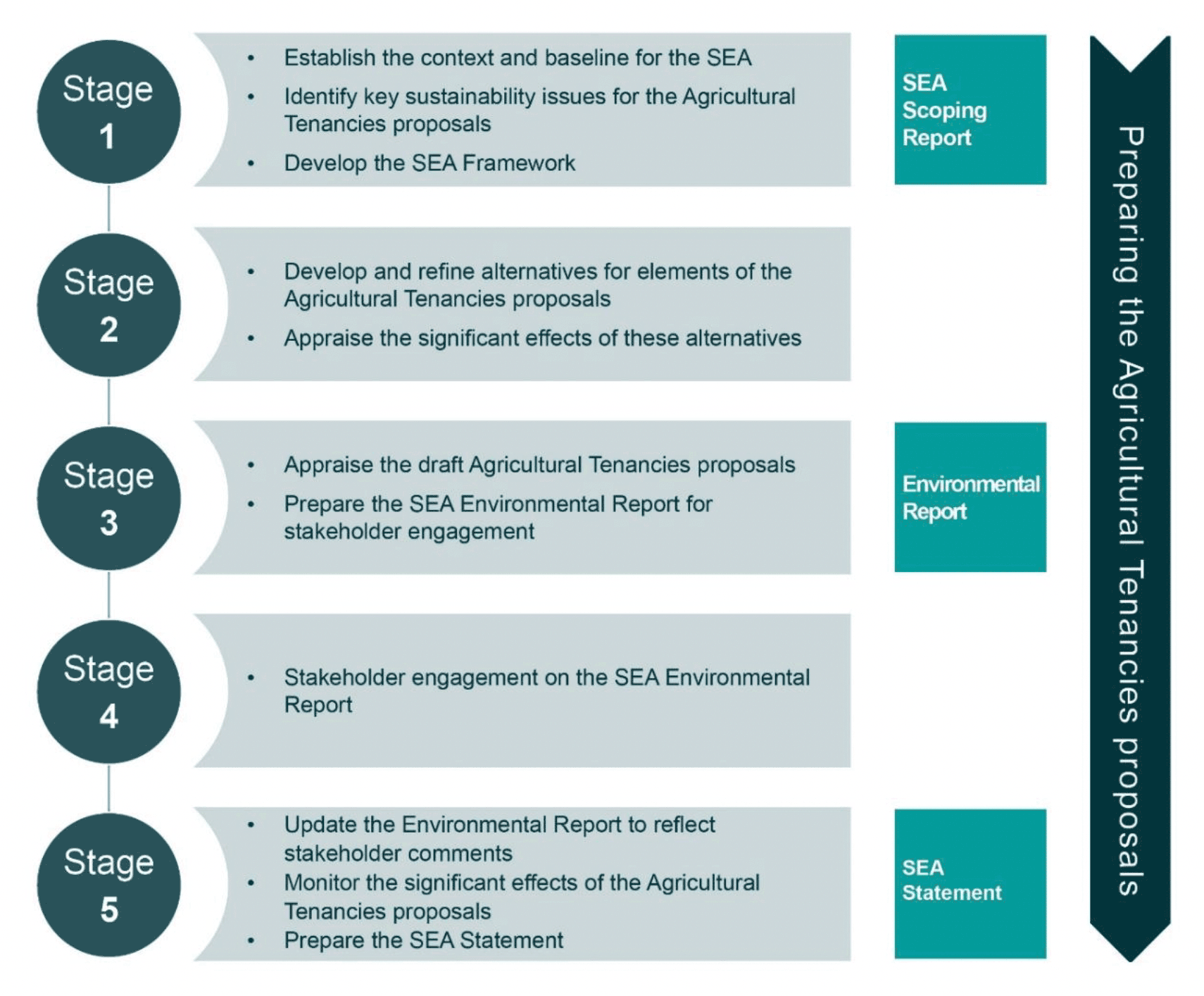
Graphic text below:
Preparing the Agricultural Tenancies proposals
Stage 1 – SEA Scoping Report:
- Establish the context and baseline for the SEA
- Identify key sustainability issues for the Agricultural Tenancies proposals
- Develop the SEA framework
Stage 2:
- Develop and refine alternatives for elements of the Agricultural Tenancies proposals
- Appraise the significant effects of these alternatives
Stage 3 – Environmental Report:
- Appraise the draft Agricultural Tenancies proposals
- Prepare the SEA Environmental Report for stakeholder engagement
Stage 4:
- Stakeholder engagement on the SEA Environmental Report
Stage 5 – SEA Statement:
- Update the Environmental Report to reflect stakeholder comments
- Monitor the significant effects of the Agricultural Tenancies proposals
- Prepare the SEA Statement
Purpose of this Environmental Report
This Environmental Report accompanies the latest version of the Agricultural Tenancies proposals and is the main output of the SEA process. Its purpose is to:
- Identify, describe, and evaluate the likely significant environmental effects of the proposals and alternative approaches; and
- Provide a perspective on the likely environmental performance of the proposals and key areas for monitoring during its implementation.
The Environmental Report is the third document to be produced as part of the SEA process for the Agricultural Tenancies proposals. The first document was the Screening Report prepared in August 2022, and the second was the Scoping Report prepared in July 2023, which included information about the baseline and the ‘framework’ against which the proposals have been assessed.
Structure of this Environmental Report
- In line with the provisions of the Environmental Assessment (Scotland) Act 2005, this Environmental Report presents:
- Chapter 3 presents an overview of the scoping process for the SEA (Stage 1).
- Chapter 4 presents an assessment of a number of alternative approaches relating to the broad principles underpinning the Agricultural Tenancies proposals. These have been assessed as reasonable alternatives (Stage 2).
- Chapter 5 presents an assessment of the current proposals, in terms of their likely significant environmental effects (Stage 3).
- Chapter 6 presents proposals for monitoring the significant environmental effects of the proposals, and opportunities for enhancements (linked to Stage 5).
- Chapter 7 subsequently sets out the next steps for the Agricultural Tenancies proposals and accompanying SEA process.
Consultation on this Environmental Report alongside the Agricultural Tenancies proposals comprises Stage 4.
Assessment of reasonable alternatives
As outlined above, Chapter 4 of the Environmental Report presents an assessment of ‘reasonable alternatives’, which is a key element of the SEA process to meet the requirements of the Environmental Assessment (Scotland) Act 2005.
In developing options to assess through the SEA process, the SEA team engaged plan-makers to understand where the focus of alternatives assessment should be. To aid in these discussions, a workshop was undertaken in June 2023 with plan-makers to discuss reasonable alternatives in the context of the proposals.
The purpose of this workshop was to discuss what options can be assessed as reasonable alternatives for the Agricultural Tenancies proposals, in conjunction with the objectives, issues, challenges and opportunities associated with the proposals.
The options formulated through the workshop relate to key components of the proposals, and are set out below:
- Diversification:
─ Option D1: Environmentally focused diversification: This option would provide an additional onus on legislation that would enable environmental enhancements and protection, providing a much easier pathway for tenants to plant trees, restore peatland, and other nature-based solutions that would improve the provision of ecosystem services.
─ Option D2: Commercial diversification: This option would seek to facilitate diversification which enables the development of commercial avenues. This could include, for example, the facilitation of tourism, leisure and recreational activities on land to provide further streams of income and support the local rural economy. It could also facilitate the use of land for renewable energy production or similar activities which support national climate change targets.
─ Option D3: Mixed approach: This option would facilitate a combination of the above diversification provisions to allow for both environmentally focused and commercial diversification amending the current diversification provisions to given affect to Option D1 and D2.
- Compensation:
─ Option C1: Continue current arrangements for compensation in association with the provisions of the Agricultural Holdings (Scotland) Act 1991.
─ Option C2: Initiate compensation arrangements that allow compensation to be payable to the tenant for land taken out of agricultural production for environmental enhancements and/or protection.
- Waygo timeframe:
─ Option WG1: Do not seek to make changes to the waygo process.
─ Option WG2: Introduce a waygo timeframe so claims are settled prior to the end of the tenancy.
- Good husbandry:
─ Option GH1: Do not seek to update the provisions relating to good husbandry.
─ Option GH2: Embed environmental principles into the definition of good husbandry.
- Provisions associated with Schedule 5 agricultural improvements:
─ Option S1: Revising and adding to the list of activities and practices currently set out in Schedule 5 of the 1991 Act, with a view to providing an exhaustive prescriptive list.
─ Option S2: Initiate a principle-based approach, replacing the current list in Schedule 5 of the 1991 Act with a series of broad principles to be engaged with through agricultural improvements.
─ Option S3: Initiate a principle-based approach, whilst also providing a list of example activities and practices which may be eligible for compensation.
Chapter 4 of the Environmental Report presents details of the options assessed and the reasoning behind their choice as reasonable alternatives. This is accompanied by an assessment of the options against the SEA Framework developed during scoping. Infographics presenting summary appraisal findings for each set of options are also set out in Chapter 4 and reproduced below.
Infographics are presented in relation to the four SEA topics and show the relative performance of each option against each other. Where there are two options, a green shading with an ‘outer ring’ is used to highlight the best performing option (ranking 1st), whilst a red shading covering an ‘inner ring’ represents the option which performs less well (ranking 2nd). Where there are three options, an orange ‘middle ring’ represents the option which performs less well (ranking 2nd), whilst a red shading covering an ‘inner ring’ represents the option which performs least favourably (ranking 3rd). Where options are ranked equally, or it is not possible to differentiate between the options, an equals sign is used within both diagrams.
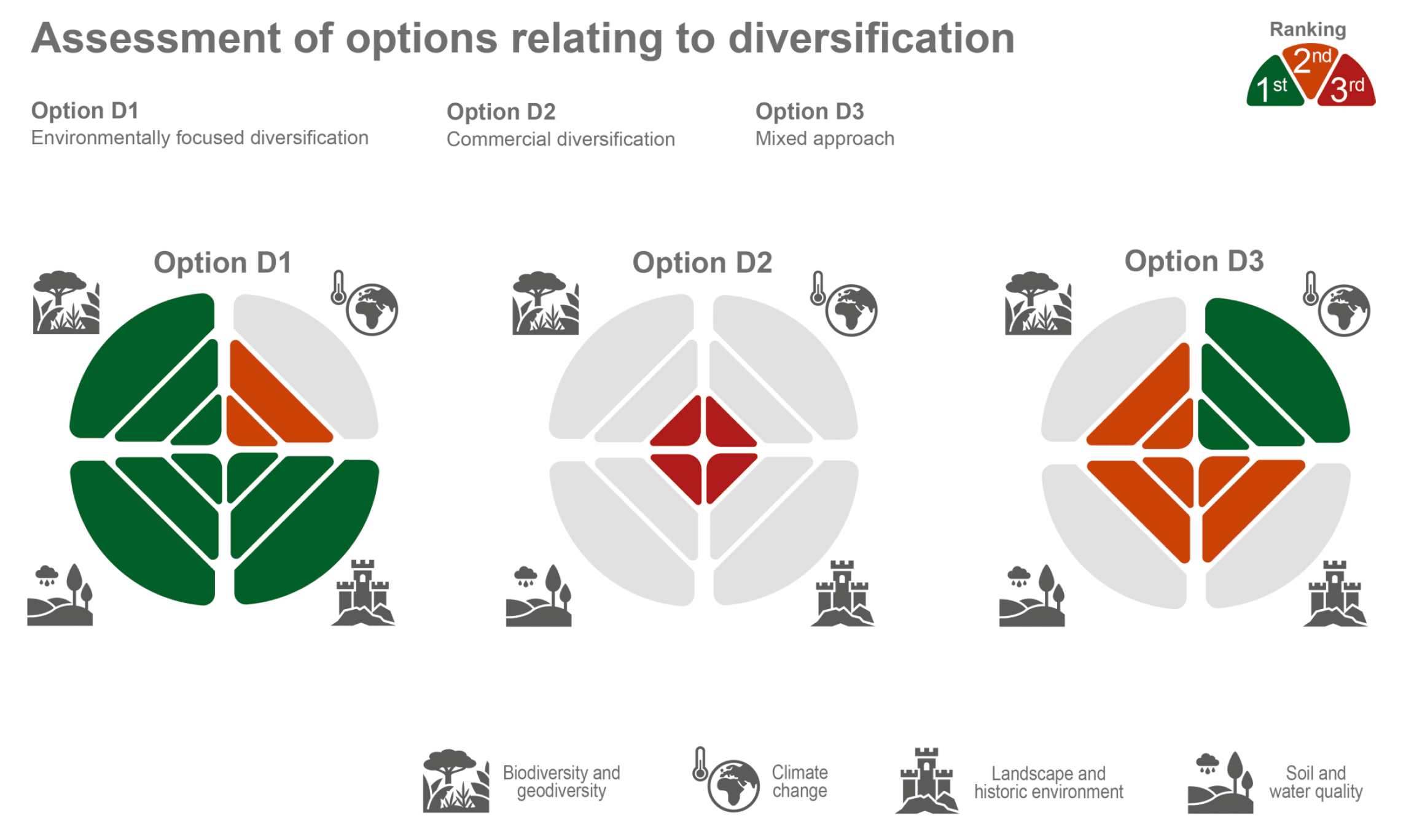
Graphic text below:
Assessment of options relating to diversification
Option D1 – Environmentally focused diversification
Ranking 1st:
- Biodiversity and geodiversity
- Soil and water quality
- Landscape and historic environment
Ranking 2nd:
- Climate change
Option D2 – Commercial diversification
Ranking 3rd:
- Biodiversity and geodiversity
- Climate change
- Landscape and historic environment
- Soil and water quality
Option D3 – Mixed approach
Ranking 1st:
- Climate change
Ranking 2nd:
- Biodiversity and geodiversity
- Soil and water quality
- Landscape and historic environment
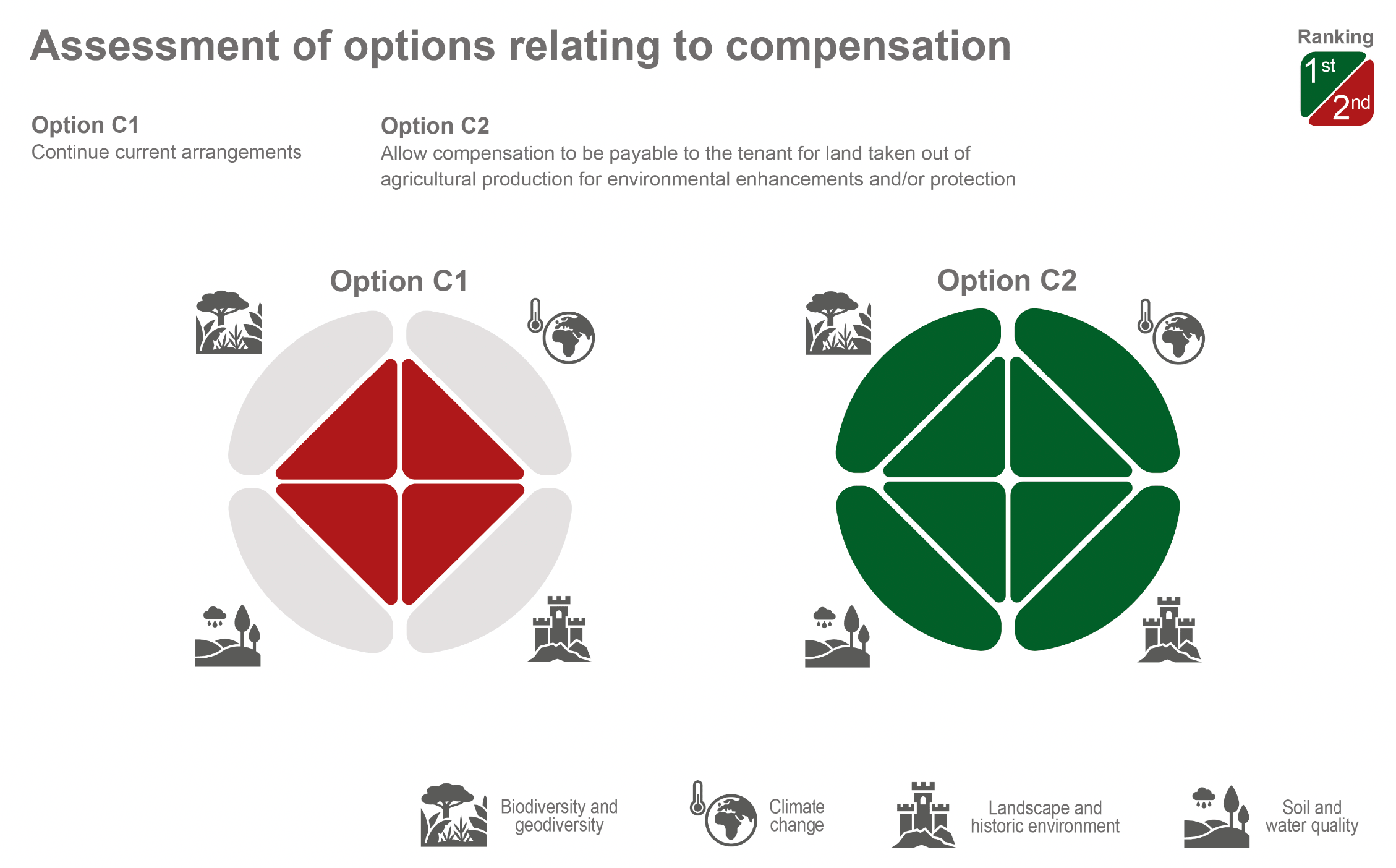
Graphic text below:
Assessment of options relating to compensation
Option C1 – Continue current arrangements
Ranking 2nd:
- Biodiversity and geodiversity
- Climate change
- Landscape and historic environment
- Soil and water quality
Option C2 – Allow compensation to be payable to the tenant for land taken out of agricultural production for environmental enhancements and/or protection
Ranking 1st:
- Biodiversity and geodiversity
- Climate change
- Landscape and historic environment
- Soil and water quality
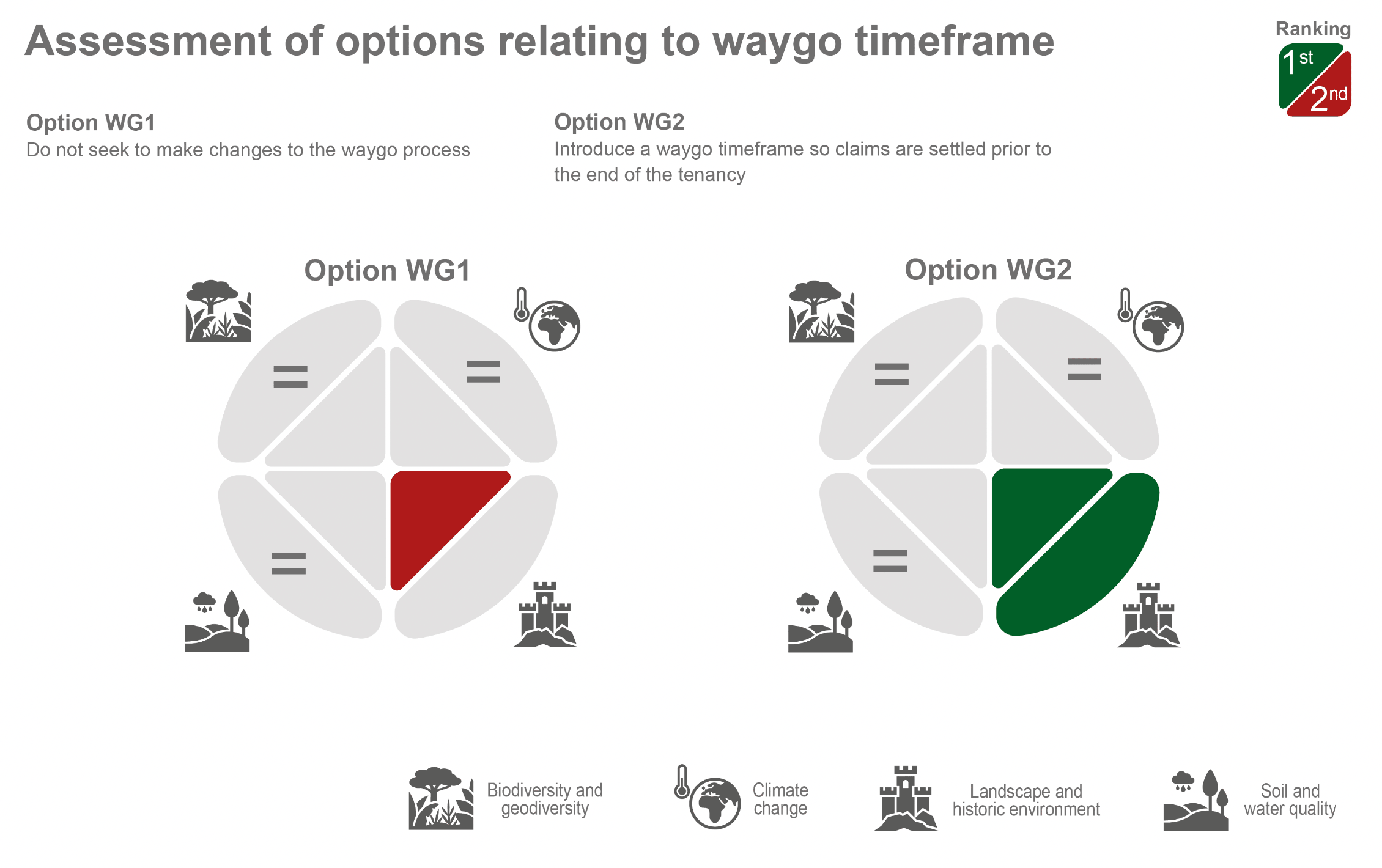
Graphic text below:
Assessment of options relating to waygo timeframe
Option WG1 – Do not seek to make changes to the waygo process
Ranking 2nd:
- Landscape and historic environment
Option WG2 – Introduce a waygo timeframe so claims are settled prior to the end of the tenancy
Ranking 1st:
- Landscape and historic environment
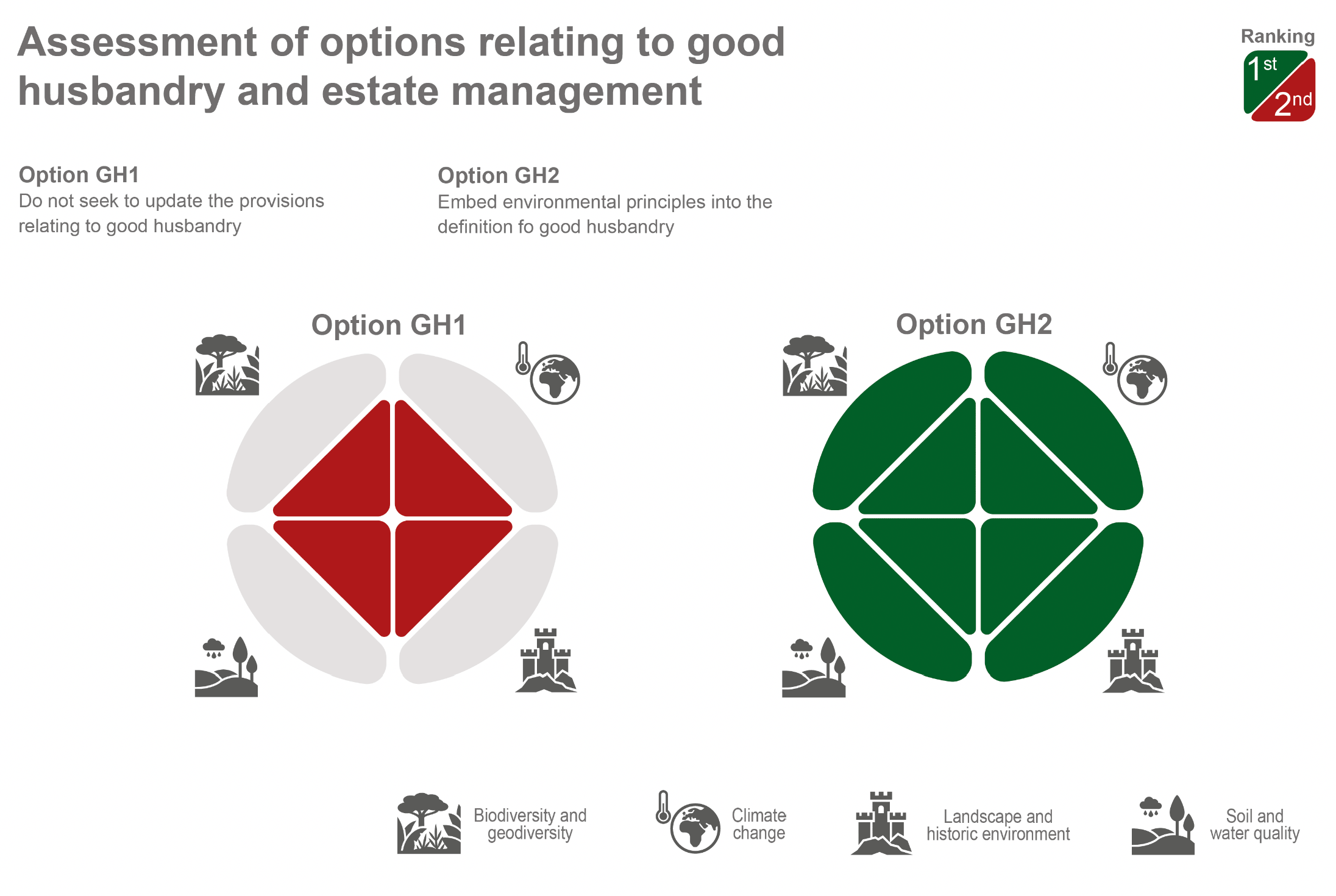
Graphic text below:
Assessment of options relating to good husbandry and estate management
Option GH1 – Do not seek to update the provisions relating to good husbandry
Ranking 2nd:
- Biodiversity and geodiversity
- Climate change
- Landscape and historic environment
- Soil and water quality
Option GH2
Ranking 1st:
- Biodiversity and geodiversity
- Climate change
- Landscape and historic environment
- Soil and water quality
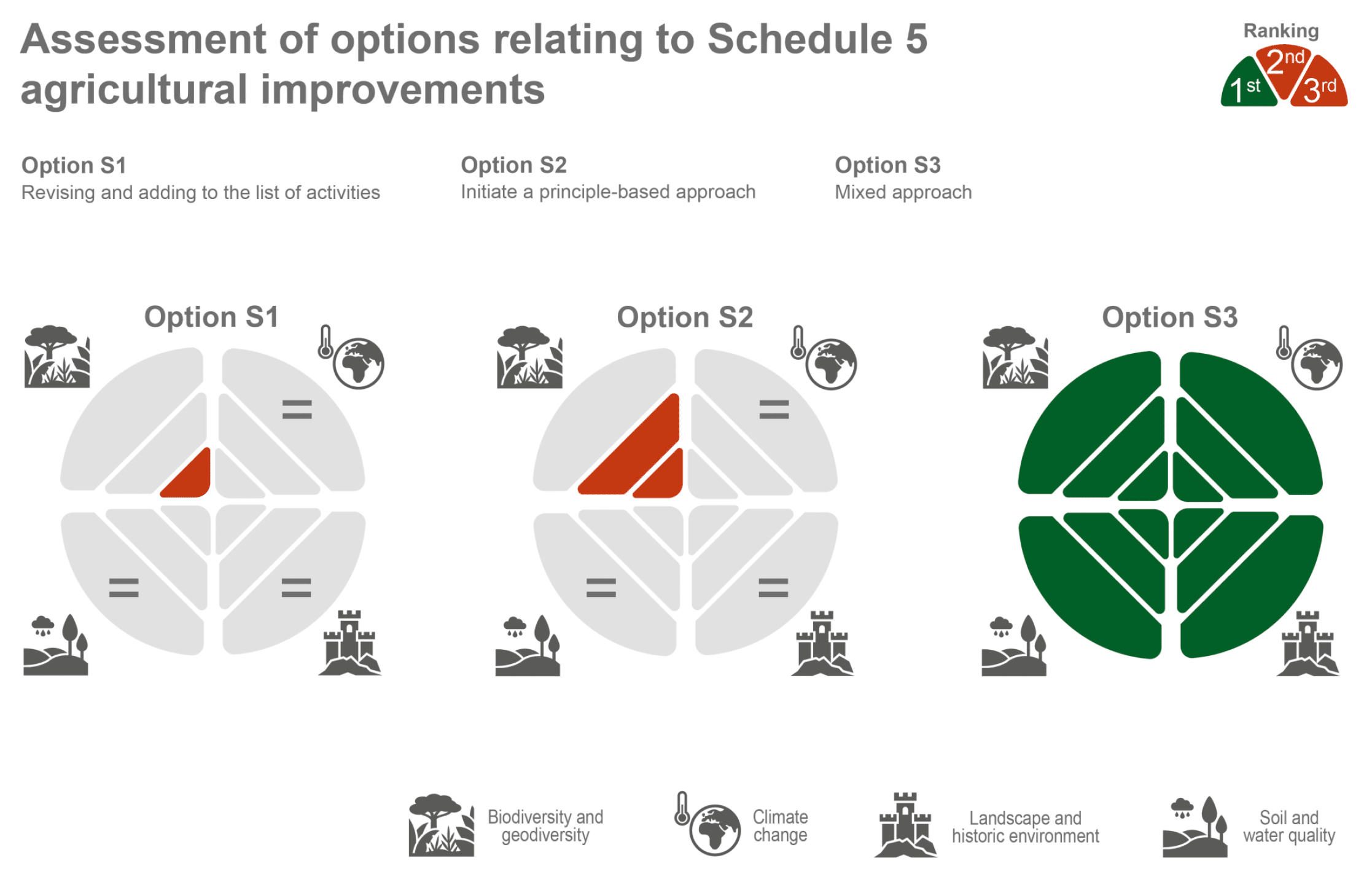
Graphic text below:
Assessment of options relating to Schedule 5 agricultural improvements
Option S1 – Revising and adding to the list of activities
Ranking 3rd:
- Biodiversity and geodiversity
Option S2 – Initiate a principle-based approach
Ranking 2nd:
- Biodiversity and geodiversity
Option S3 – Mixed approach
Ranking 1st:
- Biodiversity and geodiversity
- Climate change
- Landscape and historic environment
- Soil and water quality
Assessment of proposals
Chapter 5 of the Environmental Report presents the assessment findings and recommendations in relation to the current Agricultural Tenancies proposals.
The key elements of the proposals can be summarised as follows:
- Diversification (non-agricultural activities) – This proposal aims to provide tenant farmers with a greater opportunity to diversify their business, with a view to helping address climate change and biodiversity loss. In this context, diversification means allowing the land to be used for non-agricultural purposes.
- Schedule 5 (agricultural activities) – Schedule 5 of the Agricultural Holdings (Scotland) Act 1991 is currently an exhaustive list across three parts (I, II and III), which lacks flexibility. This proposal aims is to allow tenant farmers greater flexibility to conduct agricultural improvements and partake in integrated land management, focusing on sustainable and regenerative agriculture. This will include adding climate change mitigation and biodiversity enhancement items to Schedule 5 (such as tree planting, habitat creation and renewable energy) that are ancillary to agriculture, support food production. The aim is to add wider value to the land.
- Rules of Good Husbandry and Estate Management – The Rules of Good Husbandry and Estate Management place an obligation on all tenant farmers and landlords to practice good husbandry and estate management. The Rules are currently framed towards post war ‘efficient production’. This proposal aims to ensure that sustainable and regenerative agricultural practices are acknowledged alongside their current focus on efficient production.
The key significant effects and uncertainties identified through the assessment are summarised in the figure below.
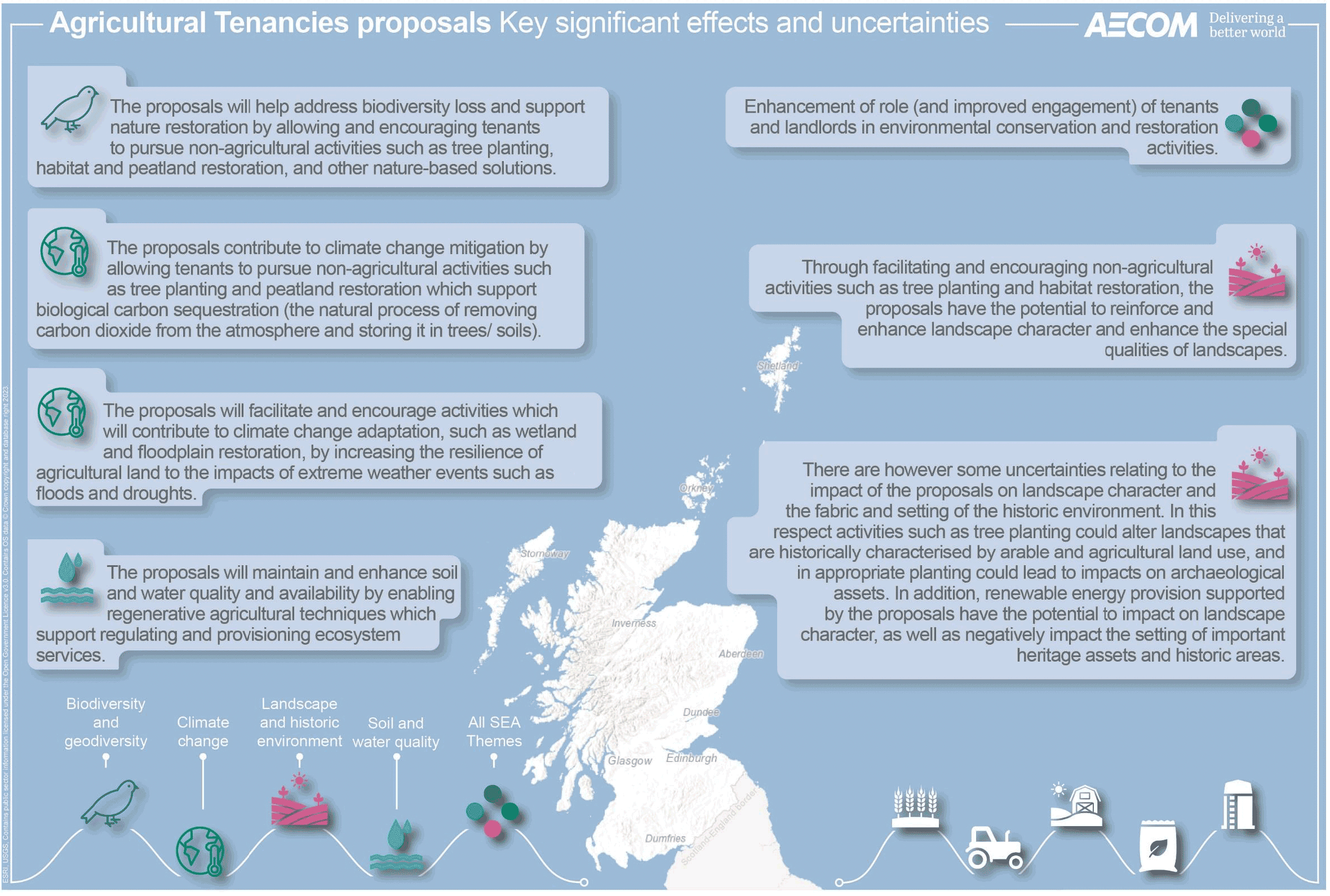
Graphic text below:
Agricultural Tenancies proposals: Key significant effects and uncertainties
Biodiversity and geodiversity:
- The proposals will help address biodiversity loss and support nature restoration by allowing and encouraging tenants to pursue non-agricultural activities such as tree planting, habitat and peatland restoration, and other nature-based solutions.
Climate change:
- The proposals contribute to climate change mitigation by allowing tenants to pursue non-agricultural activities such as tree planting and peatland restoration which support biological carbon sequestration (the natural process of removing carbon dioxide from the atmosphere and storing it in trees/soils).
- The proposals will facilitate and encourage activities which will contribute to climate change adaptation, such as wetland and floodplain restoration, by increasing the resilience of agricultural land to the impacts of extreme weather events such as floods and droughts.
Soil and water quality:
- The proposals will maintain and enhance soil and water quality and availability by enabling regenerative agricultural techniques which support regulating and provisioning ecosystem services.
Landscape and historic environment:
- Through facilitating and encouraging non-agricultural activities such as tree planting and habitat restoration, the proposals have the potential to reinforce and enhance landscape character and enhance the special qualities of landscapes.
- There are however, some uncertainties relating to the impact of the proposals on landscape character and the fabric and setting of the historic environment. In this respect, activities such as tree planting could alter landscapes that are historically characterised by arable and agricultural land use, and in appropriate planting could lead to impacts on archaeological assets. In addition, renewable energy provision supported by the proposals have the potential to impact on landscape character, as well as negatively impact the setting of important heritage assets and historic areas.
All SEA themes:
- Enhancement of role (and improved engagement) of tenants and landlords in environmental conservation and restoration activities.
Cumulative effects
A range of positive cumulative effects across the SEA themes are anticipated as a result of the in-combination effects of Agricultural Tenancies proposals and other plans and strategies. In this respect, the proposals (and framework they sit within) complement and reinforce the objectives and actions of Scotland’s Environmental Strategy, Climate Change Plan, National Strategy for Economic Transformation, NPF4 and other key plans and strategies nationally. No significant negative cumulative effects are anticipated in terms of the implementation of the proposals.
Conclusions and recommendations
Three of the four SEA themes considered through the appraisal are considered likely to lead to major positive significant effects – these are biodiversity and geodiversity, climate change, and soil and water. The proposals support activities which maintain and enhance biodiversity, contribute to climate change mitigation and adaptation, and improve soil and water quality through enabling the facilitation of a range of regenerative activities including nature-based solutions. With respect to climate change, renewable energy use also plays a key role.
Uncertainty is noted with respect to the landscape and historic environment SEA theme because activities such as tree planting could alter landscapes that are historically characterised by arable and agricultural land uses. In addition, renewable energy uses have the potential to impact the special qualities of valued landscapes as well as negatively impact the setting of important heritage assets and historic areas. In light of this, it is recommended that the proposals clarify that activities, particularly non-agricultural activities, must give due consideration to the local landscape and historic context, with activities only being supported where they maintain or enhance local landscape character and/ or setting and significance of the historic environment.
Furthermore, there are a number of actions the Scottish Government can take to alleviate this uncertainty and support and encourage agricultural tenants to undertake diversification on their land. For instance, detailed guidelines and case studies for both landowners and tenants can play a key role in demonstrating the landscape and heritage benefits that can be delivered through diversification and alleviate concerns about a changing baseline. These guidelines could profile land use options tenants could consider, for instance in terms of regenerative agricultural practices like cover cropping and riparian buffers. Guidance should include specific examples which provide advice on how the landscape features may differ to conventional approaches. This will help support clarity for tenants and landowners whilst helping to alleviate concerns. For example, cover cropping differs from the bare fallow fields of conventional agriculture by planting cereals, legumes and brassicas between crop cycles to protect soil. When strategically planted and terminated, cover crops increase organic matter, fix nitrogen, and break pest cycles. Additionally, riparian buffers establish vegetation strips along waterways rather than cropland directly adjacent to streams. The buffers filter agricultural runoff, stabilize banks, and create wildlife corridors. Showcasing these and similar practices through guidelines and highlighting the benefits can provide visual and peer reviewed evidence of how biodiversity, climate soil and water benefits can be delivered through multiple land management routes. This guidance could be delivered as part of the implementation of changes to Schedule 5 of the 1991 Act.
In addition, to address perceived uncertainties around the risks of moving to different land use practices, a piloting phase could be undertaken, focusing on demonstrator projects that provide a roadmap for agricultural tenants, how diversification can be achieved and evidence of successful implementation within a similar context. The demonstrator projects could be based on key themes relating to diversification options for instance:
- Nature enhancement and restoration
- Net zero technologies
- Eco tourism
- Regenerative agriculture
Monitoring at the landholding level will also be a key element to demonstrate to tenants and landowners alike how diversified land uses not only contribute to national biodiversity and climate targets, but also deliver productivity benefits. Monitoring can be a complex and detailed process but will be critical to ensure diversification away from traditional intensive agriculture is delivering on objectives. As such, the Scottish Government should endeavour to develop robust monitoring guidance to help landowners and tenants understand how to track habitat, soil, carbon sequestration, and other environmental improvements over time. Possibilities for monitoring could include aspects such as assessing soil organic matter content annually, monitoring species diversity and habitat surveys every three years, or undertaking soil analysis every five years to measure carbon sequestration rates and progress. From a wider landscape or national perspective, a complete biodiversity inventory mapping habitat connectivity every ten years could examine the full impact of the system.
Finally, given the cultural importance of the agriculture sector, tight margins and established practices, agricultural tenants should continually be encouraged and supported to deliver land use changes. Offering ongoing incentives could motivate adoption of diversification in line with climate and conservation goals and alleviate any perceived risk. Incentives could include initiatives such as tax reductions, cost-shares, low-interest loans and guidance and support to help landowners and tenants access environmental markets relating to biodiversity, carbon, soil and agriculture and other ecosystem services.
Proposed SEA monitoring programme
Schedule 2 of the Environmental Assessment (Scotland) Act highlights that the Environmental Report should include “a description of the measures envisaged concerning monitoring.” In response to this, Chapter 6 of this Environmental Report presents a proposed draft monitoring programme for measuring the proposals’ implementation. It draws on the identified potential significant effects identified through the assessment of the various components of the proposals, and also suggests where monitoring is required to help ensure that the potential benefits of the proposals are effectively achieved through implementation. This will enable appropriate interventions to be undertaken if monitoring highlights negative or underperforming trends relating to the proposals’ implementation.
Next steps
This Environmental Report is being consulted on alongside the wider consultation on the SEAs for the Agricultural Tenancies and Small Landholdings & Land Use Tenancies proposals.
Following the completion of the consultation period in October, comments will be reviewed and analysed. The final proposals will then be developed prior to Royal Assent. Any changes arising to the proposals will need to be assessed as part of the SEA process.
Part 3 of the Environmental Assessment (Scotland) Act 2005 requires that a ‘statement’ be made available to accompany the proposals, as soon as possible after their adoption. The purpose of the SEA Adoption Statement is to outline how the SEA process has influenced and informed the proposals’ development process and demonstrate how consultation on the SEA has been taken into account.
To meet these requirements, an SEA Adoption Statement will be published with the adopted proposals. The SEA Adoption Statement will set out: the reasons for choosing the preferred proposals in light of other reasonable alternatives; how environmental considerations were integrated into the proposals’ development process; how consultation responses were taken into account; and the measures decided for monitoring the significant effects of the proposals.
Contact
There is a problem
Thanks for your feedback